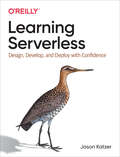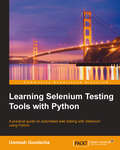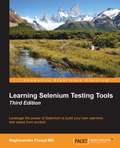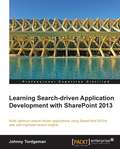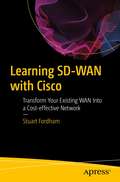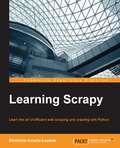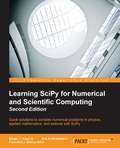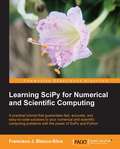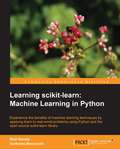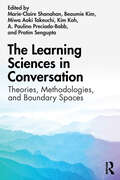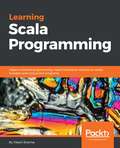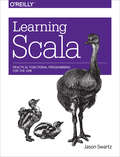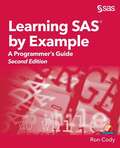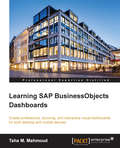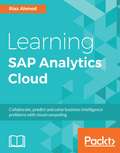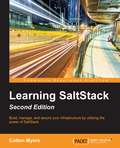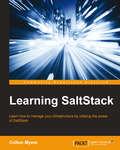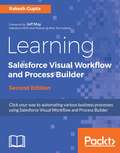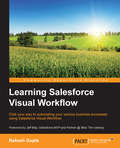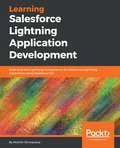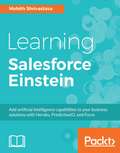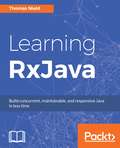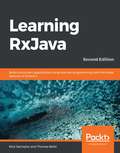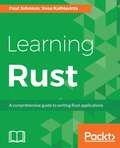- Table View
- List View
Learning Serverless: Design, Develop, And Deploy With Confidence
by Jason KatzerWhether your company is considering serverless computing or has already made the decision to adopt this model, this practical book is for you. Author Jason Katzer shows early- and mid-career developers what's required to build and ship maintainable and scalable services using this model. <P><P>With this book, you'll learn how to build a modern production system in the cloud, viewed through the lens of serverless computing. You'll discover how serverless can free you from the tedious task of setting up and maintaining systems in production. You'll also explore new ways to level up your career and design, develop, and deploy with confidence. <P><P>In three parts, this book includes:The Path to Production: Examine the ins and outs of distributed systems, microservices, interfaces, and serverless architecture and patternsThe Tools: Dive into monitoring, observability and alerting, logging, pipelines, automation, and deploymentConcepts: Learn how to design security and privacy, how to manage quality through testing and staging, and how to plan for failure
Learning Selenium Testing Tools with Python
by Unmesh GundechaIf you are a quality testing professional, or a software or web application developer looking to create automation test scripts for your web applications, with an interest in Python, then this is the perfect guide for you. Python developers who need to do Selenium testing need not learn Java, as they can directly use Selenium for testing with this book.
Learning Selenium Testing Tools - Third Edition
by Raghavendra Prasad MgIf you are a software developer with a basic knowledge of testing and are interested in automated testing using Selenium, this is the book for you. No prior knowledge of Selenium is required.
Learning Search-driven Application Development with SharePoint 2013
by Johnny TordgemanA fast paced, practical guide, filled with code examples and demonstrations of enterprise search using SharePoint 2013.This book is written for SharePoint and JavaScript developers who want to get started with SharePoint search and create search-driven applications. The book assumes working knowledge with previous versions of SharePoint and some experience with JavaScript and client side development
Learning SD-WAN with Cisco: Transform Your Existing WAN Into a Cost-effective Network
by Stuart FordhamExplore the rise of SD-WAN with CISCO and transform your existing WAN into an agile, efficient, and cost-effective network. Learning SD-WAN with Cisco helps you understand the development of SD-WAN and its benefits to modern networks. This book starts with an exploration of the different components of SD-WAN, such as vBond for orchestration, vManage for management, vSmart for control, and the vEdge devices. From there, it moves on to building a network from the ground up using EVE-NG, focusing on how to install EVE-NG, get the required licenses via a SmartNET account, download the components, and begin to create your network by installing vManage.Once you have this foundation, you will create the organization and certificates, and look at local users as well as single- and multi-tenancy options and clustering. As you continue to build your network, you will dig down into the overlay protocols used in SD-WAN, and then deploy your controllers and edge devices, looking at zero-touch provisioning along the way.After building your network, you will configure and apply policies and templates to manage the control and data planes as well as VPNs, Internet access, security, and quality of service. The book also explores reporting and management using vManage, along with upgrading and troubleshooting the various components, using techniques from simple ping and trace route through to advanced techniques such as DTLS and TLOC troubleshooting and traffic simulation.After reading this book, you will have hands-on experience working with SD-WAN. You will understand how to deploy, configure, manage, and troubleshoot it.What You Will LearnKnow what SD-WAN is, how it came about, and why we need itUnderstand troubleshooting and traffic simulation of DTLS and TLOC Monitor, report, and troubleshoot the SD-WAN environment Who This Book Is For Network professionals with experience in Linux and Cisco devices
Learning Scrapy
by Dimitris Kouzis LoukasIf you are a software developer, data scientist, NLP or machine-learning enthusiast or just need to migrate your company's wiki from a legacy platform, then this book is for you. It is perfect for someone , who needs instant access to large amounts of semi-structured data effortlessly.
Learning SciPy for Numerical and Scientific Computing - Second Edition
by Erik A Christensen Sergio J. Rojas G.This book targets programmers and scientists who have basic Python knowledge and who are keen to perform scientific and numerical computations with SciPy.
Learning SciPy for Numerical and Scientific Computing
by Francisco J. Blanco-SilvaA step-by-step practical tutorial with plenty of examples on research-based problems from various areas of science, that prove how simple, yet effective, it is to provide solutions based on SciPy.This book is targeted at anyone with basic knowledge of Python, a somewhat advanced command of mathematics/physics, and an interest in engineering or scientific applications---this is broadly what we refer to as scientific computing.This book will be of critical importance to programmers and scientists who have basic Python knowledge and would like to be able to do scientific and numerical computations with SciPy.
Learning scikit-learn: Machine Learning in Python
by Guillermo Moncecchi Raul GarretaThe book adopts a tutorial-based approach to introduce the user to Scikit-learn.If you are a programmer who wants to explore machine learning and data-based methods to build intelligent applications and enhance your programming skills, this the book for you. No previous experience with machine-learning algorithms is required.
The Learning Sciences in Conversation: Theories, Methodologies, and Boundary Spaces
by Marie-Claire Shanahan Beaumie Kim Miwa Aoki Takeuchi Kim Koh A. Paulino Preciado-Babb Pratim SenguptaThe Learning Sciences in Conversation explores the unique pluralities, complex networks, and distinct approaches of the learning scientists of today. Focused on four key scholarly areas – transdisciplinarity, design, cognition, and technology – this cutting-edge volume draws on empirical and theoretical foundations to illustrate the directions, perspectives, methods, and questions that continue to define this evolving field. Contributions by researchers are put in dialogue with one another, offering an exemplary analysis of a field that synthesizes, in situ, various scholarly traditions and orientations to create a critical and heterogenous understanding of learning.
The Learning Sciences in Conversation: Theories, Methodologies, and Boundary Spaces
by Marie-Claire Shanahan Beaumie Kim Miwa Aoki Takeuchi Kim Koh A. Paulino Preciado-Babb Pratim SenguptaThe Learning Sciences in Conversation explores the unique pluralities, complex networks, and distinct approaches of the learning scientists of today. Focused on four key scholarly areas – transdisciplinarity, design, cognition, and technology – this cutting-edge volume draws on empirical and theoretical foundations to illustrate the directions, perspectives, methods, and questions that continue to define this evolving field. Contributions by researchers are put in dialogue with one another, offering an exemplary analysis of a field that synthesizes, in situ, various scholarly traditions and orientations to create a critical and heterogenous understanding of learning.
Learning Scala Programming: Object-oriented programming meets functional reactive to create Scalable and Concurrent programs
by Vikash SharmaLearn how to write scalable and concurrent programs in Scala, a language that grows with you. Key Features Get a grip on the functional features of the Scala programming language Understand and develop optimal applications using object-oriented and functional Scala constructs Learn reactive principles with Scala and work with the Akka framework Book Description Scala is a general-purpose programming language that supports both functional and object-oriented programming paradigms. Due to its concise design and versatility, Scala's applications have been extended to a wide variety of fields such as data science and cluster computing. You will learn to write highly scalable, concurrent, and testable programs to meet everyday software requirements. We will begin by understanding the language basics, syntax, core data types, literals, variables, and more. From here you will be introduced to data structures with Scala and you will learn to work with higher-order functions. Scala's powerful collections framework will help you get the best out of immutable data structures and utilize them effectively. You will then be introduced to concepts such as pattern matching, case classes, and functional programming features. From here, you will learn to work with Scala's object-oriented features. Going forward, you will learn about asynchronous and reactive programming with Scala, where you will be introduced to the Akka framework. Finally, you will learn the interoperability of Scala and Java. After reading this book, you'll be well versed with this language and its features, and you will be able to write scalable, concurrent, and reactive programs in Scala. What you will learn Get to know the reasons for choosing Scala: its use and the advantages it provides over other languages Bring together functional and object-oriented programming constructs to make a manageable application Master basic to advanced Scala constructs Test your applications using advanced testing methodologies such as TDD Select preferred language constructs from the wide variety of constructs provided by Scala Make the transition from the object-oriented paradigm to the functional programming paradigm Write clean, concise, and powerful code with a functional mindset Create concurrent, scalable, and reactive applications utilizing the advantages of ScalaWho this book is for This book is for programmers who choose to get a grip over Scala to write concurrent, scalable, and reactive programs. No prior experience with any programming language is required to learn the concepts explained in this book. Knowledge of any programming language would help the reader understanding concepts faster though.
Learning Scala
by Jason SwartzWhy learn Scala? You don't need to be a data scientist or distributed computing expert to appreciate this object-oriented functional programming language. This practical book provides a comprehensive yet approachable introduction to the language, complete with syntax diagrams, examples, and exercises. You'll start with Scala's core types and syntax before diving into higher-order functions and immutable data structures.Author Jason Swartz demonstrates why Scala's concise and expressive syntax make it an ideal language for Ruby or Python developers who want to improve their craft, while its type safety and performance ensures that it's stable and fast enough for any application.Learn about the core data types, literals, values, and variablesDiscover how to think and write in expressions, the foundation for Scala's syntaxWrite higher-order functions that accept or return other functionsBecome familiar with immutable data structures and easily transform them with type-safe and declarative operationsCreate custom infix operators to simplify existing operations or even to start your own domain-specific languageBuild classes that compose one or more traits for full reusability, or create new functionality by mixing them in at instantiation
Learning SAS by Example: A Programmer's Guide
by Ron CodyLearn to program SAS by example! Learning SAS by Example: A Programmer’s Guide, Second Edition, teaches SAS programming from very basic concepts to more advanced topics. Because most programmers prefer examples rather than reference-type syntax, this book uses short examples to explain each topic. The second edition has brought this classic book on SAS programming up to the latest SAS version, with new chapters that cover topics such as PROC SGPLOT and Perl regular expressions. This book belongs on the shelf (or e-book reader) of anyone who programs in SAS, from those with little programming experience who want to learn SAS to intermediate and even advanced SAS programmers who want to learn new techniques or identify new ways to accomplish existing tasks. <P><P>In an instructive and conversational tone, author Ron Cody clearly explains each programming technique and then illustrates it with one or more real-life examples, followed by a detailed description of how the program works. The text is divided into four major sections: Getting Started, DATA Step Processing, Presenting and Summarizing Your Data, and Advanced Topics. Subjects addressed include
Learning SAP BusinessObjects Dashboards
by Taha M. MahmoudThis book will help beginners to create stylish and professional looking dashboards in no time. It is also intended for BI developers who want to use SAP BO to facilitate BI in their organizations. No prior knowledge is required, however, you must have a basic knowledge of MS Excel and some analytical skills to build expressive business charts.
Learning SAP Analytics Cloud
by Riaz AhmedStart making better business decisions backed by data About This Book • Predict new opportunities and risks in a few mouse clicks • Eliminate complexity with tools that let you plan, analyze, and collaborate in context—in real time • Discover, visualize, plan, and predict in a single product with agile BI tools Who This Book Is For This book targets IT professionals, business analysts, BI developers, managers, newcomers to SAP Analytics Cloud, and ultimately anyone who wants to learn from self-paced, professional guidance and needs a solid foundation in SAP Analytics Cloud. What You Will Learn • A clear understanding of SAP Analytics Cloud platform • Create data models using different data sources, including Excel and text files . • Present professional analyses using different types of charts, tables, geo maps, and more • Using stories, drill up and down instantly to analyze data from various angles • Share completed stories with other team members or compile them in SAP Digital Boardroom agendas for presentation to major stakeholders • Export the results of a story to a PDF file • Save time by planning, analyzing, predicting, and collaborating in context • Discover, visualize, plan, and predict in one product as opposed to separate solutions In Detail The book starts with the basics of SAP Analytics Cloud (formerly known as SAP BusinessObjects Cloud) and exposes almost every significant feature a beginner needs to master. Packed with illustrations and short, essential, to-the-point descriptions, the book provides a unique learning experience. Your journey of exploration starts with a basic introduction to the SAP Analytics Cloud platform. You will then learn about different segments of the product, such as Models, Stories, Digital Boardroom, and so on. Then, you are introduced to the product's interface: the Home screen, the main menu, and more. Then comes the hands-on aspect of the book, which starts with model creation. Next, you learn how to utilize a model to prepare different types of stories(reports) with the help of charts, tables, Geo Maps, and more. In the final chapters of this book, you will learn about Digital Boardroom, Collaboration, and Administration. Style and approach The easy-to-follow visual instructions provided in this book help business users and report developers create simple and complex stories (reports) quickly
Learning SaltStack - Second Edition
by Colton MyersBuild, manage, and secure your infrastructure by utilizing the power of SaltStack About This Book * First book in the market to incorporate all the latest features of SaltStack. * Leverage the power of SaltStack for building, managing and securing your infrastructure. * Effectively use commands and control the state of your infrastructure in a jiffy. Who This Book Is For This book is aimed at System Administrators who are looking forward to manage their infrastructure using SaltStack with no prior knowledge about it. What You Will Learn Install Salt on your servers Run commands on all or some of your minions instantly from a central managing server Write custom Salt modules to handle your infrastructure's unique needs Define the state of your infrastructure and use Salt to enforce that state. Create platform-agnostic state definitions for greater flexibility and power Manage virtual servers on public or private clouds using Salt Cloud Use the event system in Salt to create a reactive and self-healing infrastructure In Detail SaltStack is one of the best infrastructure management platforms available. It provides powerful tools for defining and enforcing the state of your infrastructure in a clear, concise way. With this book learn how to use these tools for your own infrastructure by understanding the core pieces of Salt. In this book we will take you from the initial installation of Salt, through running their first commands, and then talk about extending Salt for individual use cases. From there you will explore the state system inside of Salt, learning to define the desired state of our infrastructure in such a way that Salt can enforce that state with a single command. Finally, you will learn about some of the additional tools that salt provides, including salt-cloud, the reactor, and the event system. We?ll finish by exploring how to get involved with salt and what?s new in the salt community. Finally, by the end of the book, you'll be able to build a reliable, scalable, secure, high-performance infrastructure and fully utilize the power of cloud computing. Style and approach This will be a comprehensive guide on SaltStack along with installation and setting up of Salt on couple of platforms. Then enlightening the readers about remote execution system and configuration management system and ending with concepts of security and best practices.
Learning SaltStack
by Colton MyersIf you are a system administrator who manages multiple servers, then you know how difficult it is to keep your infrastructure in line. If you've been searching for an easier way, this book is for you. No prior experience with SaltStack is required.
Learning Salesforce Visual Workflow and Process Builder - Second Edition
by Rakesh GuptaClick your way to automating various business processes using Salesforce Visual Workflow About This Book • Develop an application using Point and Click with the help of Flow • Get to grips with various ways to launch a Flow • Capture data from an external user without using the Visualforce page • Save user input into the database, and learn how to query and manipulate the data • Discover various ways to debug and deploy Flow and Process Builder • Understand the concepts of Subflow and Login Flow • Handle complex business processes using Process builder and keep them clean • Use existing or new Flows to work with Salesforce Lightning Experience. Who This Book Is For This book is intended for those who want to use Flows to automate their business requirements by clicking, not coding. No previous experience in computer coding or programming is required. What You Will Learn • Develop an application using point and click with the help of Flow • Get to grips with various ways to launch a Flow • Capture data from an external user without using the Visualforce page • Save user input into the database, and learn how to query and manipulate the data • Discover various ways to debug and deploy Flow and Process Builder • Understand the concepts of Subflow and Login Flow • Handle complex business processes using Process builder and keep them clean • Use existing or new Flows to work with Salesforce Lightning Experience. In Detail Salesforce Management System is an information system used in CRM to automate the business processes like sales and marketing. To implement this, Force.com developed a powerful tool called Visual Workflow to automate business processes by creating applications also called Flows. Learning Salesforce Visual Workflow, Second Edition is a practical guide on Flows that will enable you to develop custom applications in Salesforce with minimized code usage. The book starts with an introduction to Visual Workflows that teaches all the building blocks of creating Flows and use it efficiently. You will learn how to easily automate business processes and tackle complex business scenarios using Flows. The book explains the working of the Process Builder so you can create reusable processes. The book also covers how you can integrate existing or newly created Flows with the Salesforce Lightening Experience. By the end of the book, you will get a clear understanding on how to use Flows and Process Builder in your organization to optimize code usage. Style and approach Step by step approch to use Process Builder to solve complex business requirements with the help of Flow
Learning Salesforce Visual Workflow
by Rakesh GuptaLearning Salesforce Visual Workflow is intended for those who want to use Flows to automate their business requirements by click not code. Salesforce maintains an incredibly user-friendly interface; no previous experience in computer coding or programming is required.
Learning Salesforce Lightning Application Development: Build and test Lightning Components for Salesforce Lightning Experience using Salesforce DX
by Mohith ShrivastavaBuild, design, and style beautiful and informative applications on the Salesforce Lightning platformKey FeaturesBuild and Test Lightning Components that enhance application usability and adaptabilityApply Security Best Practices to your Custom Lightning ComponentsDesign Lightning Components for Salesforce UIs such as Lightning Pages, Salesforce 1 Application, Communities, and more.Book DescriptionBuilt on the Salesforce App Cloud, the new Salesforce Lightning Experience combines three major components: Lightning Design System, Lightning App Builder, and Lightning Components, to provide an enhanced user experience. This book will enable you to quickly create modern, enterprise apps with Lightning Component Framework.You will start by building simple Lightning Components and understanding the Lightning Components architecture. The chapters cover the basics of Lightning Component Framework semantics and syntax, the security features provided by Locker Service, and use of third-party libraries inside Lightning Components. The later chapters focus on debugging, performance tuning, testing using Lightning Testing Services, and how to publish Lightning Components on Salesforce AppExchange.What you will learnUnderstand Lightning Components architecture Learn Locker security best practices Debug and Improve performance of your Lightning Components Use third-party libraries along with Lightning Component FrameworkLearn how to publish Lightning Components on AppExchangeUse Lightning Out to take your Lightning Components outside the Salesforce platformWho this book is forThis book is for Salesforce developers or developers from other platforms who are familiar with HTML, CSS, and JavaScript and want to build and test Salesforce Lightning components. No knowledge of Salesforce Lightning is required.
Learning Salesforce Einstein
by Mohith ShrivastavaIncorporate the power of Einstein in your Salesforce application About This Book • Make better predictions of your business processes using prediction and predictive modeling • Build your own custom models by leveraging PredictionIO on the Heroku platform • Integrate Einstein into various cloud services to predict sales, marketing leads, insights into news feeds, and more Who This Book Is For This book is for developers, data scientists, and Salesforce-experienced consultants who want to explore Salesforce Einstein and its current offerings. It assumes some prior experience with the Salesforce platform. What You Will Learn • Get introduced to AI and its role in CRM and cloud applications • Understand how Einstein works for the sales, service, marketing, community, and commerce clouds • Gain a deep understanding of how to use Einstein for the analytics cloud • Build predictive apps on Heroku using PredictionIO, and work with Einstein Predictive Vision Services • Incorporate Einstein in the IoT cloud • Test the accuracy of Einstein through Salesforce reporting and Wave analytics In Detail Dreamforce 16 brought forth the latest addition to the Salesforce platform: an AI tool named Einstein. Einstein promises to provide users of all Salesforce applications with a powerful platform to help them gain deep insights into the data they work on. This book will introduce you to Einstein and help you integrate it into your respective business applications based on the Salesforce platform. We start off with an introduction to AI, then move on to look at how AI can make your CRM and apps smarter. Next, we discuss various out-of-the-box components added to sales, service, marketing, and community clouds from salesforce to add Artificial Intelligence capabilities. Further on, we teach you how to use Heroku, PredictionIO, and the force.com platform, along with Einstein, to build smarter apps. The core chapters focus on developer content and introduce PredictionIO and Salesforce Einstein Vision Services. We explore Einstein Predictive Vision Services, along with analytics cloud, the Einstein Data Discovery product, and IOT core concepts. Throughout the book, we also focus on how Einstein can be integrated into CRM and various clouds such as sales, services, marketing, and communities. By the end of the book, you will be able to embrace and leverage the power of Einstein, incorporating its functions to gain more knowledge. Salesforce developers will be introduced to the world of AI, while data scientists will gain insights into Salesforce's various cloud offerings and how they can use Einstein's capabilities and enhance applications. Style and approach This book takes a straightforward approach to explain Salesforce Einstein and all of its potential applications. Filled with examples, the book presents the facts along with seasoned advice and real-world use cases to ensure you have all the resources you need to incorporate the power of Einstein in your work.
Learning RxJava
by Thomas NieldReactive Programming with Java and ReactiveX About This Book • Explore the essential tools and operators RxJava provides, and know which situations to use them in • Delve into Observables and Subscribers, the core components of RxJava used for building scalable and performant reactive applications • Delve into the practical implementation of tools to effectively take on complex tasks such as concurrency and backpressure Who This Book Is For The primary audience for this book is developers with at least a fundamental mastery of Java. Some readers will likely be interested in RxJava to make programs more resilient, concurrent, and scalable. Others may be checking out reactive programming just to see what it is all about, and to judge whether it can solve any problems they may have. What You Will Learn • Learn the features of RxJava 2 that bring about many significant changes, including new reactive types such as Flowable, Single, Maybe, and Completable • Understand how reactive programming works and the mindset to "think reactively" • Demystify the Observable and how it quickly expresses data and events as sequences • Learn the various Rx operators that transform, filter, and combine data and event sequences • Leverage multicasting to push data to multiple destinations, and cache and replay them • Discover how concurrency and parallelization work in RxJava, and how it makes these traditionally complex tasks trivial to implement • Apply RxJava and Retrolambda to the Android domain to create responsive Android apps with better user experiences • Use RxJava with the Kotlin language to express RxJava more idiomatically with extension functions, data classes, and other Kotlin features In Detail RxJava is a library for composing asynchronous and event-based programs using Observable sequences for the JVM, allowing developers to build robust applications in less time. Learning RxJava addresses all the fundamentals of reactive programming to help readers write reactive code, as well as teach them an effective approach to designing and implementing reactive libraries and applications. Starting with a brief introduction to reactive programming concepts, there is an overview of Observables and Observers, the core components of RxJava, and how to combine different streams of data and events together. You will also learn simpler ways to achieve concurrency and remain highly performant, with no need for synchronization. Later on, we will leverage backpressure and other strategies to cope with rapidly-producing sources to prevent bottlenecks in your application. After covering custom operators, testing, and debugging, the book dives into hands-on examples using RxJava on Android as well as Kotlin. Style and approach This book will be different from other Rx books, taking an approach that comprehensively covers Rx concepts and practical applications.
Learning RxJava: Build concurrent applications using reactive programming with the latest features of RxJava 3, 2nd Edition
by Thomas Nield Nick SamoylovUpdated with the latest Maven coordinates, Java programming features, and API changes, this book is your guide to solving problems in writing asynchronous and event-based programs Key Features Explore a variety of tools and techniques used to solve problems in implementing concurrency and parallelization Learn about core operators in RxJava that enable you to express your code logic productively Apply RxJava with Kotlin to create responsive Android apps with better user experience Book Description RxJava is not just a popular library for building asynchronous and event-based applications; it also enables you to create a cleaner and more readable code base. In this book, you'll cover the core fundamentals of reactive programming and learn how to design and implement reactive libraries and applications. Learning RxJava will help you understand how reactive programming works and guide you in writing your first example in reactive code. You'll get to grips with the workings of Observable and Subscriber, and see how they are used in different contexts using real-world use cases. The book will also take you through multicasting and caching to help prevent redundant work with multiple Observers. You'll then learn how to create your own RxJava operators by reusing reactive logic. As you advance, you'll explore effective tools and libraries to test and debug RxJava code. Finally, you'll delve into RxAndroid extensions and use Kotlin features to streamline your Android apps. By the end of this book, you'll become proficient in writing reactive code in Java and Kotlin to build concurrent applications, including Android applications. What you will learn Discover different ways to create Observables, Observers, and Subscribers Multicast in order to push data to multiple destinations and cache and replay them Express RxJava idiomatically with the help of Kotlin features such as extension functions and data classes Become familiar with various operators available in RxJava to perform common transformations and tasks Explore RxJava's reactive types, including Flowable, Single, Maybe, and Completable Demystify Observables and how they express data and events as sequences Who this book is for This book is for Java developers who want to leverage reactive programming to develop more resilient and concurrent applications. If you're an RxJava user looking to get to grips with the latest features and updates in RxJava 3, this book is for you. Fundamental knowledge of core Java features and object-oriented programming will assist you in understanding the key concepts covered in this book.
Learning Rust
by Paul Johnson Vesa KaihlavirtaStart building fast and robust applications with the power of Rust by your side About This Book • Get started with the language to build scalable and high performance applications • This book will help C#/C++ developers gain better performance and memory management • Discover the power of Rust when developing concurrent applications for large and scalable software Who This Book Is For The book is for absolute beginners to Rust, who want to build high performance, concurrent applications for their projects. It is suitable for developers who have a basic knowledge of programming and developers who are using the C#/C++ language to write their applications. No knowledge of Rust is expected. What You Will Learn • Set up Rust for Windows, Linux, and OS X • Write effective code using Rust • Expand your Rust applications using libraries • Interface existing non-Rust libraries with your Rust applications • Use the standard library within your applications • Understand memory management within Rust and speed efficiency when passing variables • Create more complex data types • Study concurrency in Rust with multi-threaded applications and sync threading techniques to improve the performance of an application problem In Detail Rust is a highly concurrent and high performance language that focuses on safety and speed, memory management, and writing clean code. It also guarantees thread safety, and its aim is to improve the performance of existing applications. Its potential is shown by the fact that it has been backed by Mozilla to solve the critical problem of concurrency. Learning Rust will teach you to build concurrent, fast, and robust applications. From learning the basic syntax to writing complex functions, this book will is your one stop guide to get up to speed with the fundamentals of Rust programming. We will cover the essentials of the language, including variables, procedures, output, compiling, installing, and memory handling. You will learn how to write object-oriented code, work with generics, conduct pattern matching, and build macros. You will get to know how to communicate with users and other services, as well as getting to grips with generics, scoping, and more advanced conditions. You will also discover how to extend the compilation unit in Rust. By the end of this book, you will be able to create a complex application in Rust to move forward with. Style and approach This comprehensive book will focus on the Rust syntax, functions, data types, and conducting pattern matching for programmers. It is divided into three parts and each part of the book has an objective to enable the readers to create their own applications at an appropriate level, ultimately towards creating complex applications.
